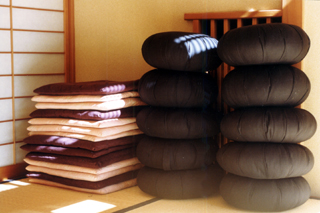Shôyôan (Tatami Room)
"Shôyôan" was built in September 1987, by master carpenter Takagaki Hiroshi and his apprentice Kaneko Ryosei, using traditional Japanese tools and techniques. The room was designed by Dewey Webster, a San Francisco architect, and Michael Curtis, Wesleyan's architect, with considerable input from the carpenters and East Asian Studies faculty members.
The studio name of this room is Shōyō-an. Shōyō means “to stroll” and, by extension, “to let the heart roam freely beyond the confines of everyday life.” It is a Japanese adaption of the Freeman name. Shōyō is also used as the Japanese translation for the Greek peripatos, the covered walk in the Lyceum where Aristotle taught his disciples, and so has clear associations with pedagogy. Finally, Tsubouchi Yūzō (1859-1935), the renowned Japanese scholar and translator of Shakespeare, chose Shōyō as his penname. Thus by using Shōyō in the name of our room, we honor a man who served as a bridge between Japanese and Western culture. An, literally a “thatched hut,” is a conventional suffix attached to the name of a house or tea room.
In a traditional Japanese house, a room such as "Shôyôan" would function as a multi-purpose space, serving alternately as living room, dining room, study, and bedroom, according to the needs of the family. In a similar manner, "Shôyôan" provides the Center with a space that is used variously for teaching, formal reception, tea ceremony, and viewing the garden.
 The size of a traditional Japanese room is measured by the number of straw mats (tatami) covering the floor. At six mats, "Shôyôan" is of about average size for a Japanese room. The mats are covered with woven reeds (igusa), providing a smooth and resilient surface that is well-suited to the activities of Japan's floor-oriented domestic culture. Much of the aesthetic effect of a Japanese room is the result of a subtle harmony arising from the juxtaposition of differently textured building materials. Most of the wood seen here is American cedar in its natural state, while accents are provided by the sills of cherry (sakura), the main post or alcove post (tokobashira) of Japanese cedar (sugi), and the beam above the alcove, which is stained teak. The tokobashira is a perfectly formed cedar trunk, stripped of its bark to reveal vertical ripples induced by binding the young tree with small twigs. The translucent doors (shoji) across the long side of the room are constructed of cedar and Japanese paper. The lower panel of each can be raised to offer a view of snow falling into the garden, and for this reason they are called "snow-viewing" (yukimi) shoji. Yet another contrasting accent is provided by the rich pattern of the opaque papered door (fusuma), which serves as the host's entrance during tea ceremonies.
The size of a traditional Japanese room is measured by the number of straw mats (tatami) covering the floor. At six mats, "Shôyôan" is of about average size for a Japanese room. The mats are covered with woven reeds (igusa), providing a smooth and resilient surface that is well-suited to the activities of Japan's floor-oriented domestic culture. Much of the aesthetic effect of a Japanese room is the result of a subtle harmony arising from the juxtaposition of differently textured building materials. Most of the wood seen here is American cedar in its natural state, while accents are provided by the sills of cherry (sakura), the main post or alcove post (tokobashira) of Japanese cedar (sugi), and the beam above the alcove, which is stained teak. The tokobashira is a perfectly formed cedar trunk, stripped of its bark to reveal vertical ripples induced by binding the young tree with small twigs. The translucent doors (shoji) across the long side of the room are constructed of cedar and Japanese paper. The lower panel of each can be raised to offer a view of snow falling into the garden, and for this reason they are called "snow-viewing" (yukimi) shoji. Yet another contrasting accent is provided by the rich pattern of the opaque papered door (fusuma), which serves as the host's entrance during tea ceremonies.
The focal point of the room is the recessed alcove (tokonoma), with its raised floor of cherry. The alcove is never entered, but is used instead to highlight a work of art such as a painted scroll or a flower arrangement. The mat in front of the tokonoma is the position of greatest honor, where the principal guest sits during the tea ceremony.

